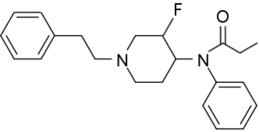NFEPP
 | |
| Clinical data | |
|---|---|
| Drug class | Opioid |
| Identifiers | |
| |
| ChemSpider | |
| Chemical and physical data | |
| 3D model (JSmol) | |
| |
| |
(±)-N-(3-fluoro-1-phenethylpiperidin-4-yl)-N-phenylpropionamide, or NFEPP for short, is an analgesic opioid chemical, similar in structure to fentanyl, designed in 2016 by Spahn et al. from Free University of Berlin[1] to avoid the standard negative side effects of opiates, including opioid overdose, by only targeting inflamed tissue.[2]
Inflamed tissue
Inflamed tissue has a lower pH value (~5–7) than non-inflamed tissue (7.4).[3] Through computer simulation, scientists found a way to make the fentanyl analog only affect inflamed tissue via the addition of fluorine to the chemical structure. In experiment, it was shown that NFEPP produced injury-restricted analgesia in rats with different types of inflammatory pain without exhibiting typical opiate effects, including respiratory depression, sedation, constipation, and chemical seeking behavior.
As a result, NFEPP has the potential to reduce opioid addiction and dependency, as there is no effect on users who are not actually suffering from pain, as the chemical does not interact with non-inflamed brain tissue.
References